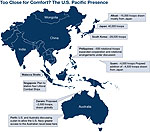Partnerships bolster U.S. military pivot to Pacific
 With more than half of the world’s land and population as its responsibility, the task facing Pacific Air Forces is sometimes daunting.
With more than half of the world’s land and population as its responsibility, the task facing Pacific Air Forces is sometimes daunting.
“The Indo-Asian Pacific is vast and it is complex,” said Gen. Lori Robinson, commander of Pacific Air Forces and air component commander for U.S. Pacific Command. “It is more than 60 percent of the world’s population,” including speakers of nearly 3,000 languages.
“In 50 years, seven of every 10 people in the world will live here,” she said.
That’s why, Robinson said, it’s important for U.S. forces to maintain partnerships with Pacific nations.
“Presence is our ability to be in places, not bases, and to build on our friendship with our allies and partners throughout the region,” she said. “If you have great presence, you will be able to build great partnerships.”
The Air Force recently concluded joint training exercises with multiple Pacific nations, including Japan, South Korea, Australia, New Zealand, Singapore and Vietnam. That cooperation is key to preparing responses for natural disasters that will affect the region.
“We’re on the Ring of Fire,” Robinson said, referring to the geological area that covers most of the Pacific. Consisting of increased seismic and volcanic activity, it’s an area scientists have often warned is ripe for cataclysms.
“It’s not a matter of if a disaster is going to happen, but when,” Robinson said, adding that cooperation among Pacific nations can lead to faster response time and more humanitarian aid when emergencies strike.
When the earthquake hit Nepal in April — killing an estimated 9,000 people — international cooperation allowed military forces to deploy on the ground quickly with relief supplies.
“When something like Nepal happens, we’ve been working together already,” Robinson said.
“We downloaded over 4 million pounds from over 94 aircraft, we flew 171 sorties, 730 flight hours and we airlifted over 800 short tons,” she said of her command’s efforts.
International cooperation is also needed to confront aggressors, Robinson said. The South China Sea has become an increasingly contested region, with reports of near-misses between Chinese and American planes.
China has been using a series of islands — some of them artificially made — to set up military outposts in the region. The nation claims the South China Sea is part of its territory, a statement that has brought protests from other Asian nations such as Japan and Vietnam.
Any intercepts between planes have been “safe and standard,” Robinson said, but she added that the U.S. and China are continuing to negotiate standards of conduct in the region.
“Over the course of the last year, the United States and China have been talking about the rules of behavior in international airspace and have been working on coming up with agreements,” Robinson said. “It’s in the diplomatic channels now.”
At the same time, however, the Pentagon’s focus has shifted over the past year to the Middle East with the Islamic State group, and to Europe with Russia and Ukraine.
“As we go through global force management, if necessary, we can deploy forces from here,” Robinson said. “We also do realize that there are other things happening in the world, and our need to support all of that is important.”
But the so-called pivot to the Pacific is still “very strong,” Robinson said.
“It is a reinforcement of our presence here in the region,” she said. “It’s a recommitment of our engagement with our partners and allies.”